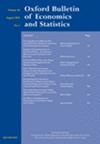贝弗里奇曲线、匹配和劳动力市场流动:一个重新解释
IF 1.4
3区 经济学
Q2 ECONOMICS
引用次数: 0
摘要
贝弗里奇曲线的一个标准理论是基于匹配函数:当失业率高时,职位空缺被迅速填补,因此需要更少的职位空缺来平衡失业的流入。估计面板数据的匹配函数,我们发现没有(或非常弱)证据表明,当失业率高时,职位空缺会迅速填补。一个有在职搜索的模型可以解释贝弗里奇曲线,当职位空缺以恒定的速度被填补时:当失业率高时,失业的求职者填补的职位空缺比例更大,因此需要更少的职位空缺来平衡失业的流入。本文章由计算机程序翻译,如有差异,请以英文原文为准。

The Beveridge Curve, Matching, and Labour Market Flows: A Reinterpretation
A standard theory of the Beveridge curve is based on the matching function: when unemployment is high, vacancies are filled quickly, so fewer vacancies are needed to balance the inflow into unemployment. Estimating matching functions on panel data, we find no (or very weak) evidence that vacancies are filled quickly when unemployment is high. A model with on-the-job search can explain the Beveridge curve when vacancies are filled at a constant rate: when unemployment is high, unemployed job seekers fill a larger share of the vacancies, so fewer vacancies are needed to balance the inflow into unemployment.
求助全文
通过发布文献求助,成功后即可免费获取论文全文。
去求助
来源期刊

Oxford Bulletin of Economics and Statistics
管理科学-统计学与概率论
CiteScore
5.10
自引率
0.00%
发文量
54
审稿时长
>12 weeks
期刊介绍:
Whilst the Oxford Bulletin of Economics and Statistics publishes papers in all areas of applied economics, emphasis is placed on the practical importance, theoretical interest and policy-relevance of their substantive results, as well as on the methodology and technical competence of the research.
Contributions on the topical issues of economic policy and the testing of currently controversial economic theories are encouraged, as well as more empirical research on both developed and developing countries.
 求助内容:
求助内容: 应助结果提醒方式:
应助结果提醒方式:


